Image of the Day Archives
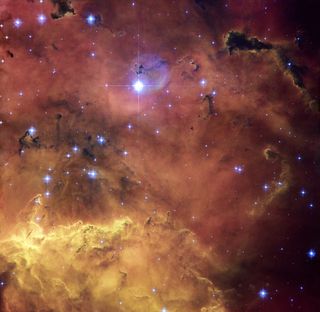
For older Image of the Day pictures, please visit the Image of the Day archives. Pictured: NGC 2467.
Cracking Up

Monday, Dec. 2, 2013: This image of Martian terrain shows the intersection of several fractures on the floor of Echus Chasma. One "sector" shows evidence of filling by a more recent viscous lava flow. Researchers consider Echus Chasma as the water source region that formed Kasei Valles, a large valley that extends thousands of kilometers to the north. The HiRISE spacecraft, which obtained the image, may assist in determining the relative roles of lava and water in the region.
— Tom Chao
Red Light Glowing

Tuesday, Dec. 3, 2013: Sh2-64 is an emission nebula in the constellation of Serpens. The nebula represents the 64th item in the catalog of 312 objects compiled by U.S. astronomer Stewart Sharpless in 1959 (2nd edition). Emission nebulas consist of clouds of interstellar gas excited by a nearby energy source, such as a star, causing the gas to glow with light, as the name suggests.
— Tom Chao
Strange

Wednesday, Dec. 4, 2013: A peculiar galaxy known as NGC 660 lies around 45 million light-years away from us. Researchers classify it as a "polar ring galaxy," as it possesses a belt of gas and stars around its center ripped from a near neighbor about one billion years ago. A cosmic rarity, only about a dozen more of these galaxies have been discovered since 1978. NGC 660’s polar ring does not appear in this image, but it contains other features that make it interesting to astronomers. Its central bulge lies strangely off-kilter and, even more intriguingly, researchers believe it may harbor exceptionally large amounts of dark matter. In late 2012, astronomers observed a massive outburst emanating from NGC 660 around ten times as bright as a supernova explosion, possibly caused by a jet shooting out of the supermassive black hole at the center of the galaxy.
— Tom Chao
'Stairway to Eden'

Thursday, Dec. 5, 2013: Astrophotographer Michael Ciuraru sent in a photo of the Milky Way rising in Acadia National Park, Maine. He indicates that he took the shot at the top of the steps that lead to Bass Head Harbor Lighthouse, and the red light comes from the lighthouse. He titled the image: "Stairway to Eden." [See more sky images from readers.] Image submitted Nov. 26, 2013.
— Tom Chao
Cosmic Dust
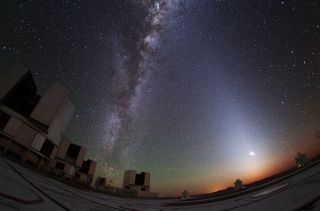
Friday, Dec. 6, 2013: The Milky Way rises (left of center) above the European Southern Observatory’s Very Large Telescope (VLT) at Paranal Observatory in Chile. At right, a band of roughly triangular diffuse light lies along the ecliptic, the apparent path of the sun in the sky as seen from the Earth. This light comes from the scattering of sunlight by dust floating between the planets which travel in the plane of the solar system. The dust is called cosmic dust or interplanetary dust. This area in the sky is also known as the zodiac, which contains the traditional zodiacal constellations, so the glow is known as zodiacal light.
— Tom Chao
A Whiter Shade of Mercury
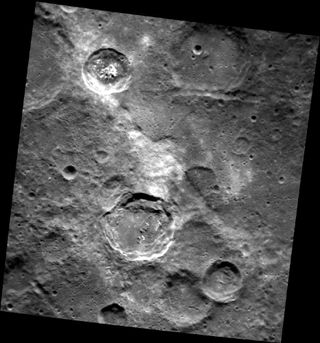
Monday, Dec. 9, 2013: MESSENGER spacecraft obtained this image of Mercury’s surface showing a high-reflectance area seemingly confined to a region of lower elevation bounded by linear scarp (cliff) segments. Such diffuse bright areas sometimes relate to the deposition of small secondary craters and ray segments by a relatively recent impact crater. However, regional images show no rayed craters in the immediate vicinity (except Han Kan). So a compositional difference might account for the difference in the albedo (brightness) of the material in the low-lying area. Are the scarps the result of vertical movement along faults, or were they formed by secondary crater chains? Researchers also have yet to explain the hollows on the central peak of the crater at upper left, and the smooth impact melt on the floor of the terrace-walled crater just below center.
— Tom Chao
Get the Space.com Newsletter
Breaking space news, the latest updates on rocket launches, skywatching events and more!
Gathered Together
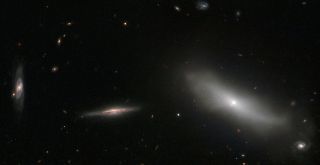
Tuesday, Dec. 10, 2013: This image depicts galaxies in the constellation of Eridanus (The River). NGC 1190, at the right, belongs to Hickson Compact Group 22 (HCG 22). The four other members of this group lie out of frame: NGC 1189, NGC 1191, NGC 1192, and NGC 1199. This photo includes 2MASS J03032308-1539079 (center), and dCAZ94 HCG 22-21 (left), neither a part of HCG 22. Astronomer Paul Hickson observed only 100 of these groups of galaxies. A Hickson Compact Group must contain at least four members, each one fairly bright and compact. Researchers believe these short-lived groups end their lives as giant elliptical galaxies.
— Tom Chao
High Above the Ground
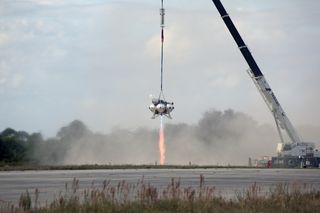
Wednesday, Dec. 11, 2013: The Project Morpheus prototype lander’s engine blasts and smoke pours out during a tether test on Dec. 6, 2013, at NASA’s Kennedy Space Center in Florida. During the test, a crane lifted the lander 20 feet, then it ascended another 10 feet. The lander was scheduled to have maneuvered backwards 10 feet, and then flown forward and descended to its original position, landing at the end of the tether onto a transportable launch platform. Morpheus utilizes an autonomous landing and hazard avoidance technology, or ALHAT, payload permitting it to obtain clear landing sites on its own, for future exploration beyond earth orbit.
— Tom Chao
This Solar Coil

Thursday, Dec. 12, 2013: Solar Dynamics Observatory (SDO) spacecraft caught a close view of tight packs of coils around one active region on the sun, Nov. 18-19, 2013. The bundles of coils consist of charged particles swirling along magnetic field lines. Other field lines heading off to the left appear more elongated and tapered. SDO took the image in extreme ultraviolet light.
— Tom Chao
Did a Vehicle Come From Somewhere Out There Just to Land in the Andes?

Friday, Dec. 13, 2013: On Dec. 5, 2013, Dr. Koichi Wakata tweeted this image of South America taken aboard the ISS. He wrote: "Flying over the beautiful Andes. pic.twitter.com/pBC3dw4M7w." Wakata represents the Japan Aerospace Exploration Agency (JAXA) as a Flight Engineer on International Space Station (ISS) Expedition 38 and the Commander of Expedition 39. [See our gallery of Expedition 37/38 images.]
— Tom Chao
Join our Space Forums to keep talking space on the latest missions, night sky and more! And if you have a news tip, correction or comment, let us know at: community@space.com.

